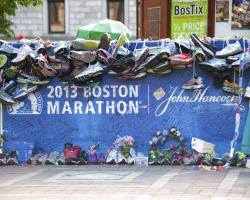Finding the Courage to Go on After Catastrophe
Get downloadable PDF.
Get downloadable PowerPoint presentation.
What Happened
The Boston Marathon was run Monday, April 21, the day after Easter. About 36,000 runners participated in the 26.2-mile event, America’s most famous and prestigious road race. However, this year, the marathon took on extra significance.
Last year, the Boston Marathon was at the center of a terrorist attack. Two homemade bombs exploded near the finish line about four hours into the race, killing three people and injuring 264 more.
Days later, law enforcement officials began to hunt for brothers Dzhokhar and Tamerian Tsarnaev. Tamerian was killed in a shootout with police April 19, and Dzhokhar was captured and charged with the bombings shortly thereafter. He’s still awaiting trial.
However, the apprehension of Dzhokhar did little to ease the pain of those injured in the blast. Some lost their legs in the explosion; others have suffered from emotional difficulty; and the race this year has been a powerful and difficult reminder of one of the worst days of their lives.
“Everyone is saying that they can’t wait for Tuesday morning,” 18-year-old survivor Sydney Corcoran told USA Today a few days before the race, “that they can just wake up and it’s over.” Sydney, who was waiting for her aunt to cross the finish line, nearly died in the explosion—shrapnel slicing through one of the arteries in her leg. Even returning to the city and seeing the marathon’s trademark blue-and-yellow colors made her physically sick. “I threw up because everything got to me,” she said.
Still, she planned to be at the finish line, as was her mother, Celeste, who lost both legs in the bomb. They plan to run the very last part of the marathon with Celeste’s sister, Carmen, hoping to hold hands as they cross the finish line. “I hope it feels like a weight just sliding off us when we cross that line,” Sydney says.
A year after the bombing, the city of Boston came out in force to hold a safe, cathartic and joyous race. More than 1 million people came out to watch—twice as many as had shown up the year before. The hashtag #BostonStrong made a comeback across the country.
“This year, the Boston Marathon belongs to the world,” wrote Boston Globe columnist Dan Shaughnessy. “It stands as a symbol of American freedom and a population refusing to cower to terrorism…Long may it run.”
Talk About It
Probably not many of us were at the finish line of the Boston Marathon that day, so we can’t say what it was like. However, in times of adversity—even if that adversity doesn’t directly impact us—we tend to want to help. We feel for the people who hurt. We do what we can even if it’s just posting messages of support on Facebook.
Can you think of other times your family, church or community rallied together during a crisis? Did you pray for the victims in Boston? Have you given aid to survivors of earthquakes or tsunamis in far corners of the world?
Disasters don’t always show up on the national news. Adversity can take all sorts of shapes, and they’re often deeply personal, be it the loss of a home, the death of a family member, or the fracturing of an important relationship. We’ll all experience disaster to some degree in our lives. Can you think of a time when your community suffered a disaster (e.g., fires or floods)? What about your church? Your family?
It’s not easy to move past disaster. The people of Boston know all too well. Yet as Sydney and her family shows us, it can be done. How did you move past your own personal adversity? How long did it take? If you were trying to help someone go through their own disaster, what advice would you give? What would you say to those affected? What would you try to do for them?
What the Bible Says
“We are afflicted in every way, but not crushed; perplexed, but not driven to despair; persecuted, but not forsaken; struck down, but not destroyed” (2 Cor. 4:8-9).
“Have I not commanded you? Be strong and courageous. Do not be frightened, and do not be dismayed, for the Lord your God is with you wherever you go” (Josh. 1:9).
“I know how to be brought low, and I know how to abound. In any and every circumstance, I have learned the secret of facing plenty and hunger, abundance and need. I can do all things through Him who strengthens me” (Phil. 4:12-13).
Paul Asay has covered religion for The Washington Post, Christianity Today, Beliefnet.com and The (Colorado Springs) Gazette. He writes about culture for Plugged In and wrote the Batman book God on the Streets of Gotham (Tyndale). He lives in Colorado Springs with wife, Wendy, and his two children. Follow him on Twitter.




